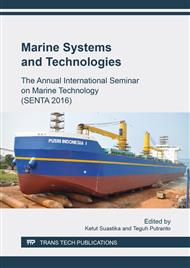p.53
p.64
p.71
p.81
p.88
p.96
p.105
p.114
p.121
Design HMI (Human Machine Interface) for Process Control System of Main Diesel Engine Fuel System
Abstract:
Controlling and monitoring of ship fuel treatment system is based on the needs of safety and business. Therefore, ship automatic fuel system is a support system recommended by ship classification society, engine manufacture, and shipping company. The new system may give highly efficiency operation and supervision. In this research, we developed marine diesel fuel system interface to monitor how the systems work. Main diesel engine fuel system consist of transfer system, separation system, feed system, and circulation system. The aim of this research is to control and display the shipboard fuel system. All valves, pumps, and separator units were controlled by programmable logic controller using tank level switches as input signal. We have tested this automation system with a computer simulations. As an initial step, valves, pumps, and separator units are successfully controlled and displayed. Based on program simulation, the operational leading time of settling tank and day tank are one hour and 9,8 hours, respectively. It is mean both of one settling tank or day tank are ready before the another tank empty. This system also have detection ability due to system failure.
Info:
Periodical:
Pages:
88-95
Citation:
Online since:
January 2018
Authors:
Price:
Сopyright:
© 2018 Trans Tech Publications Ltd. All Rights Reserved
Share:
Citation:


